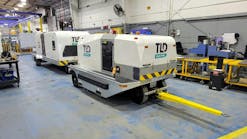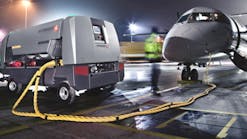A pre-conditioned air (PCA) hose can have its share of problems. Considering 91 feet of hose weighs about 1,000 pounds, it can be heavy. Hoses are often unwieldy, may kink and get wet and dirty.
To address those problems, B GSE Group, whose core business is system engineering and commissioning, started manufacturing the CoolJet Hose Retriever, a pre-conditioned air hose handling system.
The CoolJet Hose Retriever makes the process of extending and retracting the hose easier and faster, increases hose performance, and allows ground personnel to utilize just the amount of PCA hose needed, limiting hose wear and tear.
To operate the system, B GSE president Bryan Bullerdick says an operator presses a button on a remote, which is mounted to the aircraft connector at the end of the hose, while walking to or from the aircraft. This allows the user to retract or extract the hose with little effort. The remote control operates on a “dead-man” switch concept that requires a continuous press of the button to maintain motion.
While other hose handling systems have reels and baskets, the CoolJet does not. Therefore, there’s no lifting or rolling of the hose required.
Bullerdick says B GSE set out to focus on customer operational challenges related to hose handling and lifespan. A goal, he says, was to develop the easiest and fastest method to extend and retract the PCA hose. The method chosen also increases hose performance and ultimately assists customers in their tactical need to condition the aircraft and their strategic desire to turn off the auxiliary power unit (APU) and diesel-powered ground support equipment, he says.
Before B GSE started manufacturing the CoolJet Hose Retriever in the United States, the company researched hose management systems, which have been popular in Europe for about two decades. Bullerdick notes competition for the best product has been robust with at least four competitive offerings in that region. B GSE reached out to users of these systems in Europe and in 2017-18 talked to the system manufacturers.
“Our due diligence in investigating proven technology led us to the ATES [Aviation Technical Equipment Supplies] design with a 20-year track record,” he says.
B GSE found customer reviews of the ATES SHR PCAir Hose Retriever manufactured in Italy were favorable, with end-users praising the durability, size, weight and flexibility of the installation. In 2019 B GSE and ATES signed an agreement for B GSE to own the rights to manufacture the hose handling system in the Americas.
Bullerdick says key features of the system include a remote wireless control panel, a backup local control panel, touchscreen maintenance human-machine interface (HMI), adjustable speed and a compact design that allows the unit to be mounted under the passenger boarding bridge cab.
Installing the CoolJet Hose Retriever unit directly under the cab of the passenger boarding bridge, according to Bullerdick, is “an advantageous location relative to the aircraft connection ports, an ideal location for the inlet from the PCAir unit and the best arrangement to balance loads on the passenger boarding bridge.
According to Bullerdick, CoolJet Hose Retriever units have been integrated into passenger boarding bridges for two popular passenger boarding bridge manufacturers in the U.S. In addition, he says the company has supplied combination mounting systems to include mounting 400Hz and cable coilers – all organized under the passenger boarding bridge cab.
Main Components
The main components of the CoolJet Hose Retriever system are the hose, which is a flexible fabric hose made with yellow PVC with an insulating layer. The hose sections are joined by a zipper and a protective band with Velcro. Standard hose lengths are 68 and 91 feet., while other lengths are available upon request. The width of the hose is 35.5 inches.
Four individually powered ribbed belts run along the outside of the wire-wound spiral hose and draw the hose into a storage tube. Bullerdick says extraction and retraction processes are smooth as a drivehead uses four concentric drive belts powered by four speed-controlled motors. The hose system’s speed is programmable, and sensors stop the hose when it is fully extended or retracted.
When the hose is in motion, the hose management system (HMS) is interlocked to the PCA to prevent it from running. The HMS also is interlocked to the boarding bridge to prevent it from moving until the hose is fully retracted.
Only the amount of hose required needs to be extracted, which Bullerdick says is often much less than the total hose length. With a shorter hose and less need to bend or kink the hose, there also is less temperature loss.
When not in use, the hose is protected in the storage tube, reducing overall hose wear.
The PCA unit is oriented in the optimal position for airflow, Bullerdick says, thereby reducing pressure and thermal loses.
“HVAC is a precious commodity,” Bullerdick says. “The moment the air leaves the source of production, it is either warming up, cooling off or slowing down, which in all cases is not in the direction you want it to go. In developing an HVAC or PCA system, your system needs to look at how to improve delivery. General rules in developing a good or great system include: limit distance of delivery, limit how many times you have to change directions of the airflow and look to eliminate any restrictions or kinks in delivery. The system B GSE has put together is the most direct, straight and obstruction-free path from the PCA unit and the aircraft. B GSE has studies that show airflow and air temperature improvements of 20 percent or more compared to any other system installed. Having a system design that improves performance by 20 percent means there are consequently energy efficiencies. The design and materials used in the CoolJet HMS unit additionally help minimize losses by ensuring smooth, corrosion-resistant airflow.”
System controls include the electronic control and command panel, installed at the foot of the gangway, which houses the fixed control devices – including a diagnostic touchscreen and local redundant operator control panel. Also included is a radio control system with a wireless transmitter mounted on the HMS body, and a wireless receiver and remote operator panel mounted on the aircraft connector of the hose. The transmitter contains the extraction and retraction controls.
“The CoolJet has been very well received,” Bullerdick says. “We have worked very closely with our customers in launching this product in the USA since 2019 and we have found the design to be robust and reliable, as expected given the 20-year history overseas. The results have been impressive with the ability to fit on almost any passenger boarding bridge with minimum impact to bridge wear and maintenance while greatly increasing the use of our customers investment in ‘green’ GSE technology.
“On several occasions the operators would describe to our technicians how effective and useful the product is. One even approached us while changing a hose because he was concerned we were taking it out of service and he didn’t want to lose it.”





